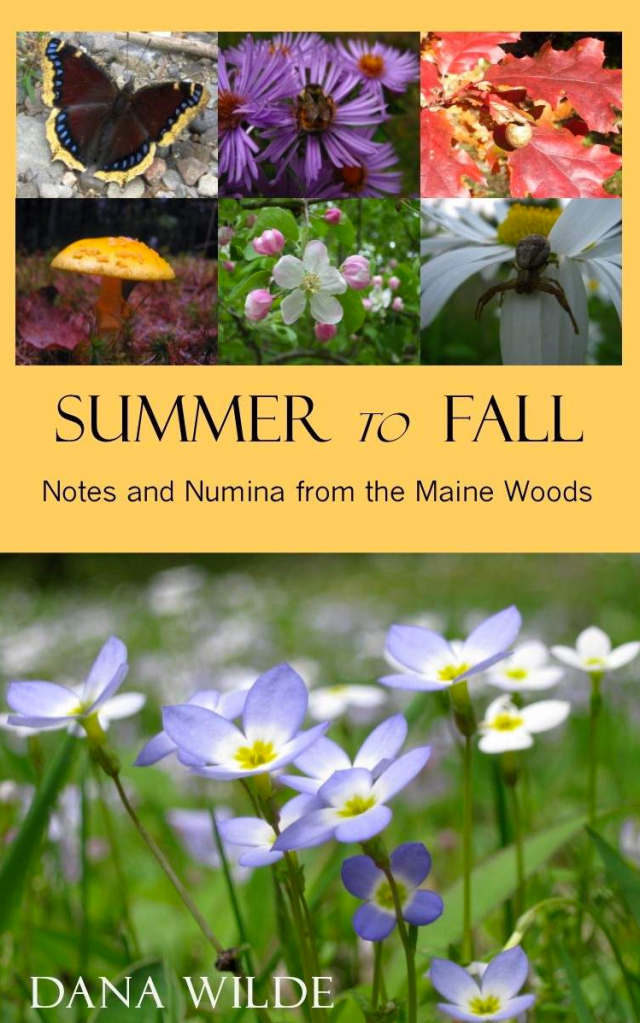In “Summer to Fall: Notes and Numina from the Maine Woods” ($16.95), newspaper columnist and Troy resident Dana Wilde focuses on a time of year when Maine has “the most gorgeous weather in the world.” The task he sets himself writing about this period is not easy, he writes: “Exposing the feel of an autumn day requires a delicate verbal balance that is never precisely struck. But the exact moment when summer breaks into fall is never precisely struck in nature, either.”
We’ve excerpted his essay “Notes from October.” “Summer to Fall” collects Wilde’s columns, most of which first appeared in the Kennebec Journal and Morning Sentinel. It was published by North Country Press in August.
THIS YEAR the red maple beside the driveway burst into flame a couple of weeks later than the usual September schedule. Every fall it goes up in a great tree conflagration over a week or two, then casts off all its scarlet leaves at once, usually in leaf-stripping wind and rain. Brown and gold carpets appear on lawns up and down Route 9. The birches dropped leaves at the usual steady pace that begins in September and lasts into November, and the deck is disappearing under their brown and yellow litter. The first trees to get naked are the ash trees, in September. Come to think of it they’re the last to cover up in May, too, which might imply something about their libido. Probably not, that’s arboreal anthropomorphism. Still, they’re beautiful, plain and simple, and apparently needing more sleep than the rest.
The orb-weaving spider who moved in under the deck rail during August has curled up there and hardly moves any more. The conifer seed bugs are finding their way into the warmth of the house. I toss them out before somebody tries to kill them and causes a piney stink.
The birds in this particular autumn have been unusually sparse. In some Octobers we fill the feeders twice a day, but this year even the blue jays have shown up only occasionally to pilfer morsels from the cats’ dish. A hundred years ago our clearing on the hillside was a cow pasture, and now it’s enclosed by hefty pines, hemlocks and hardwoods, so our dooryard doesn’t usually harbor a large avian diversity anyway. Mostly chickadees flitting from tree to tree and blue jays bullying them off every perch. A few red-breasted nuthatches have turned up, but squads of mourning doves that often patrol the firs have this fall been absent. A barred owl haunted the woods all summer, asking the other ghosts who cooks for you? all night, but he hasn’t been heard since the eclipse. A few downy woodpeckers. Different sparrows, tufted titmice appearing and disappearing like foreign tourists. Crows overhead. One chilly morning what looked like a bear cub came barreling out of an oak tree and flapped across the driveway. It turned out to be a turkey.
A few juncos showed up in mid-October, hopping around on the ground and in the lower branches like tiny horizontal pogo sticks. Normally they blow through for a week or ten days going south and then again in late March headed north. But this particular fall there have been just that handful for a day or two. Maybe the warm weather in early October encouraged them to forage off the beaten paths. Still, you’d think the ever-slanting sunlight would tell them the tale of imminent cold.
We don’t rake leaves because we need all the dirt-making material we can get. So usually I mow them to create a sort of mulch I hope will decompose under melting spring snow and reinforce our ledgy slopes. Next week chopped-up maple, oak and birch leaves will be corrugating the grassy parts of the yard. Next year’s firewood is cut, split, stacked and permanently covered beside the Shed. Life goes on, and the seasons, and everything else.
Send questions/comments to the editors.



Success. Please wait for the page to reload. If the page does not reload within 5 seconds, please refresh the page.
Enter your email and password to access comments.
Hi, to comment on stories you must . This profile is in addition to your subscription and website login.
Already have a commenting profile? .
Invalid username/password.
Please check your email to confirm and complete your registration.
Only subscribers are eligible to post comments. Please subscribe or login first for digital access. Here’s why.
Use the form below to reset your password. When you've submitted your account email, we will send an email with a reset code.